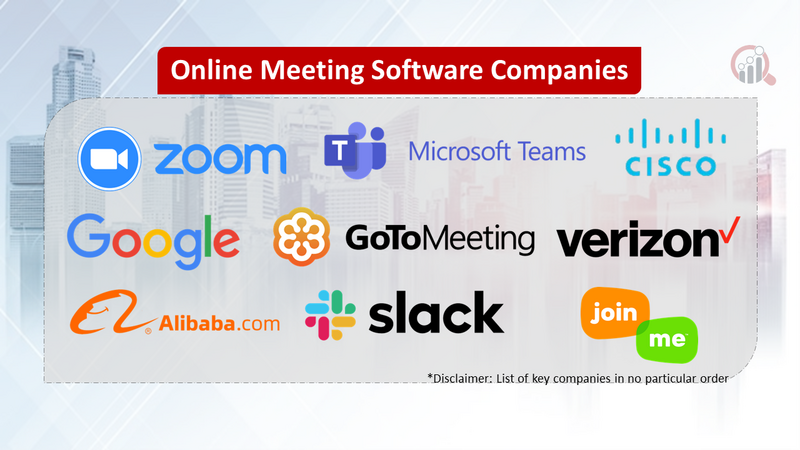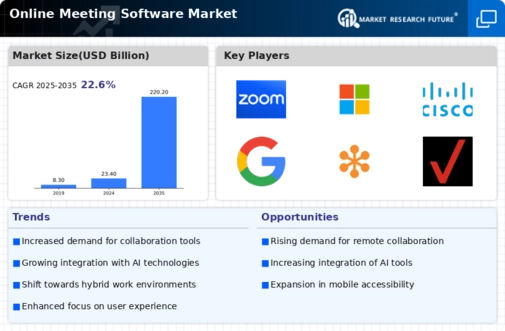Top Industry Leaders in the Online Meeting Software Market

Competitive Landscape of Online Meeting Software Market:
The online meeting software market has undergone a meteoric rise in recent years, propelled by the global shift towards remote work and virtual collaboration. This dynamic landscape is home to a diverse range of established players and rising contenders, all vying for market share and mindshare. Understanding this competitive landscape is crucial for both established vendors and aspiring entrants seeking to navigate the market's complexities.
Key Players:
- Zoom
- Microsoft Teams
- Cisco
- GoToMeeting
- Verizon
- Alibaba
- Slack
- me
- Adobe
- AnyMeeting
- RingCentral
- Zoho
- Jitsi
- Lifesize
Strategies for Success:
- Feature Differentiation: Platforms are constantly evolving, adding features like real-time translation, AI-powered transcripts, and interactive whiteboards to stand out from the crowd.
- Security and Privacy: Trust is paramount in the online meeting space. Players are beefing up security measures, ensuring data encryption and compliance with privacy regulations.
- Integration and Interoperability: Seamless integration with existing productivity tools and communication platforms is key to user adoption. Open APIs and flexible integrations are becoming increasingly important.
- Subscription Models and Pricing: Attracting a diverse user base requires a variety of pricing plans. Freemium models, tiered subscriptions, and enterprise-specific packages are becoming commonplace.
- Partnerships and Acquisitions: Strategic partnerships with hardware providers, software vendors, and telecom companies can expand reach and enhance offerings. Acquisitions are also used to acquire new technologies and talent.
Market Share Analysis:
- Deployment Model: Cloud-based solutions dominate the market, offering scalability and flexibility. On-premise options cater to specific security needs and legacy infrastructure.
- End-User Type: Large enterprises, SMEs, and educational institutions have varying requirements and budget constraints. Platforms need to cater to specific segments with tailored features and pricing.
- Regional Dynamics: The market is geographically diverse, with North America and Europe leading the way. Emerging markets in Asia-Pacific and Latin America present significant growth potential.
New and Emerging Companies:
- Focus on Niche Verticals: Companies like TeleHealth.com and doc.ai specialize in online healthcare consultations, while Onna and Fireflies cater specifically to educators and learners.
- Leveraging AI and VR: Platforms like Spatial and Dreamland are pioneering immersive virtual meeting experiences, aiming to replicate the feeling of in-person interactions.
- Open-Source and Community-Driven: Jitsi and BigBlueButton offer open-source alternatives, attracting tech-savvy users who prioritize cost-effectiveness and customization.
Current Investment Trends:
- Security and Privacy: Increased focus on data security and compliance regulations is driving investments in encryption technology, privacy-centric features, and security audits.
- Artificial Intelligence: AI is being integrated for features like automated meeting transcriptions, sentiment analysis, and virtual assistants, improving meeting efficiency and engagement.
- Augmented Reality and Virtual Reality: Investments in AR/VR technology aim to create more immersive and interactive meeting experiences, blurring the lines between physical and virtual collaboration.
- Remote Work Infrastructure: Platforms are integrating with hardware solutions like headsets and smart displays to optimize remote workspaces and enhance user experience.
Latest Company Updates:
Aug 2023, This report provides an overview of the leading vendors in the online meeting software market and their strengths and weaknesses.
Jan 2024, 10 Best Video Conferencing Software in 2024: This article offers a comparison of popular online meeting software options based on various factors like features, pricing, and ease of use.









